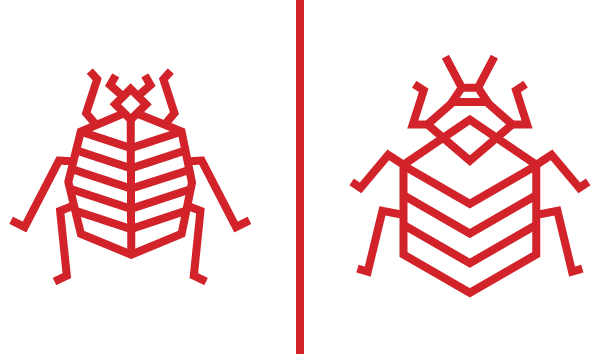 Both fleas and bed bugs are parasitic insects that can bring unwanted stress to your life. Known for leaving behind unpleasant insect bites, fleas and bed bugs are a huge pain to deal with. Unfortunately, both pests reproduce extremely quickly and can create a full-blown infestation in a matter of weeks. While they both can make you itch, several things set the two apart from each other. Here are some tips to help you tell the two apart so you can develop a plan of attack.
Both fleas and bed bugs are parasitic insects that can bring unwanted stress to your life. Known for leaving behind unpleasant insect bites, fleas and bed bugs are a huge pain to deal with. Unfortunately, both pests reproduce extremely quickly and can create a full-blown infestation in a matter of weeks. While they both can make you itch, several things set the two apart from each other. Here are some tips to help you tell the two apart so you can develop a plan of attack.
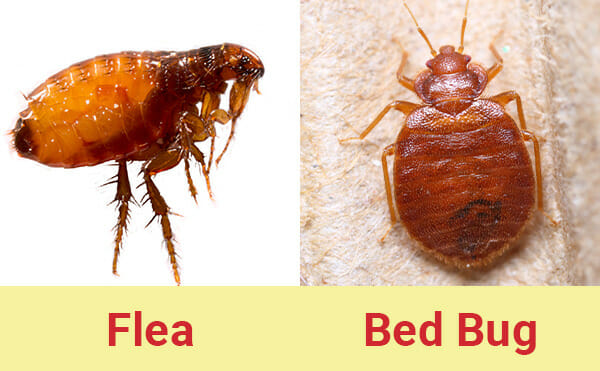
What Fleas and Bed Bugs Look Like
One of the reasons fleas and bed bugs are commonly confused is due to their similar appearances. Both are small, wingless reddish brown insects and are only a couple of millimeters long. Since they are so tiny and will easily escape when spotted, it can be difficult to observe key differences. However, if you notice a dead bug, you may have an opportunity to analyze it.
Where bed bugs are flat and look like apple seeds, fleas have a more oval shape that tends to be long and skinny. Fleas are also smaller, ranging in length from 1.5 mm to 3.3 mm. Bed bugs and fleas are both visible to the human eye, but both fleas and bed bugs often enter homes unnoticed. Unfortunately, most people don’t notice fleas and bed bugs until they notice bites.
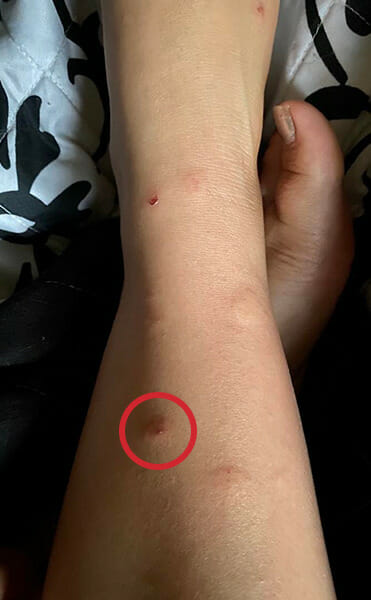 Flea Bites vs. Bed Bug Bites
Flea Bites vs. Bed Bug Bites
If you’re noticing unusual bites on your skin or your pets’ skin, you may be able to more easily identify what kind of pest infestation you are dealing with. While every person and animal reacts differently to bug bites, there are a couple of things you can look for.
Flea bites are most commonly found on the legs, feet, waist, or armpits but can appear anywhere the insect has access. The bites will often look red, swollen, somewhat blotchy, and may constantly itch. There may be a dark red center in the bite, from the single puncture of the flea’s specially built mouth. They commonly come with rashes as well and are often described as resembling a cluster of mosquito bites. Fleas will bite humans and pets alike, and the bites tend to be quite similar no matter the host.
Bed bug bites are typically different from flea bites and can resemble small, hard, swollen lumps similar to a mosquito bite and appear most often on the hands, neck, and arms. Like with fleas, bed bug bites may itch as well. These red bumps often appear in a straight row or line, consisting of three or four bites, though this is not always the case.
What about mosquito bites?
Mosquito bites can be very similar to both flea bites and bed bug bites. The most important thing to note is you’re not nearly as likely to encounter mosquitos in the home as you are fleas and bed bugs. In particular, if you notice you are waking up with bites on your body, it’s probably not a mosquito problem and you’ll want to start evaluating other behavior indicators to determine if it’s fleas or bed bugs.
**With any of these pests, it is possible to develop an allergic reaction. If you experience significant swelling, blisters, or overwhelming itchiness not relieved by over-the-counter antihistamines or cortisone, seek medical attention from a physician.
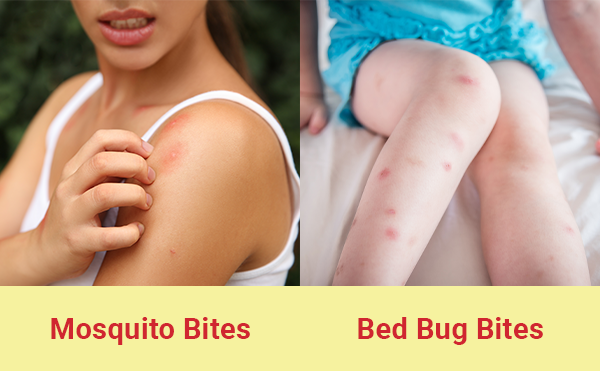
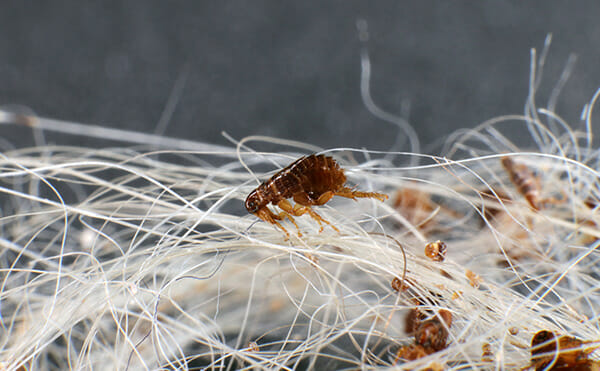
Flea Behavior and Signs of a Flea Infestation
Fleas transport themselves on household pets and wild animals and are parasites that feed on the blood of any warm-blooded body. Fleas don’t fly, but they can jump remarkably high and move fast. The most common species is the cat flea, which often feasts on cats, dogs, and humans. One adult flea can lay between 150 and 300 eggs every week, creating a severe flea problem very quickly.
Where Fleas Hide
Fleas are most often found clinging to your pets, making themselves at home in animal sleeping areas. Fleas will not typically want to leave animal hosts, but as fleas reproduce, they will usually lay eggs in pet fur that can fall off. Before too long, the eggs will hatch, and you may start to notice fleas lurking in your upholstery or carpeting, waiting to hop on you or your pets for a bite.
Signs of Fleas
If you start to notice your animals itching more than usual, you might want to do a flea check. You will likely notice fleas on your animals before you notice them anywhere else. Fleas tend to like to hide as close to the skin of dogs and cats as possible, but a good place to check is your pet’s belly. You may see blotches of irritated pink skin caused by flea bites. Fleas will also leave behind specks of brown fecal matter that look like dust. And of course, you may actually see a flea running across your pet as you check.
In particularly bad infestations, you will see fleas hopping up off the ground. By that point, you will have likely noticed fleas on your pets or you, and it’s definitely time to call a professional pest control company.
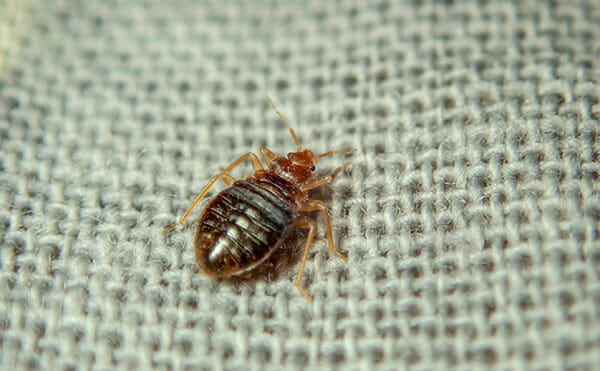
Bed Bug Behavior and Signs of a Bed Bug Infestation
Bed bugs are excellent hitchhikers. They hide in purses, luggage, and other personal belongings to find a human food supply. These bugs likely get their name from their habit of feeding on humans while they sleep in their beds. One adult bed bug can lay 200 eggs in a lifetime and a colony can pose a significant bed bug problem within weeks.
Bed Bug Hiding Places
Both fleas and bed bugs are considered to be nocturnal, meaning they seek they are more active at night in search of blood meals. Bed bugs are likely to be digesting meals on the piping of your mattress, in and around the bed frame or box spring, along the baseboards, and creeping around in other well-hidden cracks and crevices.
Signs of Bed Bugs
Other than finding itchy red spots on your skin when you wake up, there are some other telltale signs of bed bugs you can look for. You may notice specks of blood or feces on your sheets. Some people report a musty odor in the bedroom, though this isn’t always present
Treatment Options for Fleas
Treat your pets with flea and tick medication.
If you do have fleas in your home, they probably came in on one of your pets. To avoid future infestations, make sure your dogs and cats are protected through oral or topical medication during flea and tick season. These treatments vary in active ingredients, but you can talk to your veterinarian to determine which solution will work best for your furry friends.
DIY flea treatments.
While you can try to handle a flea infestation on your own, it’s a difficult and often overwhelming process. There are lots of different options to consider, like flea traps and foggers. If you don’t use these over-the-counter solutions correctly, they may not work, and even worse, they can pose serious risks to the items, people, and pests in your home. It’s natural to want to address the problem as fast as possible, but DIY flea treatments simply don’t usually work as well as ones applied by professional exterminators.
Clean your home.
One of the most important steps to get rid of fleas is ensuring you thoroughly clean your home. Flea eggs will fall off pets and land on pet bedding, carpets, beds, couches, rugs, and other surfaces.
To make sure fleas are gone, you’ll need to vacuum. Vacuuming will suck up live fleas and eggs. If you neglect to vacuum, unhatched eggs may eventually mature into adults, and the flea problem you thought you handled can crop up again.
You’ll also want to wash any laundry that may have had contact with the fleas, including clothes, blankets, pet bedding, linens, and even pillows. Wash everything on the hottest setting you can, and make sure you use detergent.
Treatment Options for Bed Bugs
Tidy your bedroom.
While bed bugs can infest couches and other pieces of furniture, in most cases, bed bugs will stick to bedrooms. Like with fleas, you’ll want to make sure you wash all your linens on the hottest heat setting you can with detergent. You’ll also want to vacuum your mattress, under your bed, your box spring, and your bedroom floor. Cleaning is only one part of the treatment–in order to make sure bed bugs are gone, you’re going to need some kind of pesticide.
DIY bed bug treatments.
For the most part, any DIY bed bug treatments will not be effective. Natural products and chemical-forward solutions are readily available at home improvement stores. These products are not professional-grade and can be difficult to use correctly. Bed bugs are excellent hiders and can easily scurry away, avoiding applied treatments.
Professional Pest Control Services Are Best for Fleas and Bed Bugs
Whether you have fleas or bed bugs, early detection and treatment are crucial. While bed bugs do not pose any major health risks, fleas are known carriers of bacterial infections, as well as the now-rare bubonic plague. Parasitic insects like fleas and bed bugs can be particularly unsettling, but we are here to bring back peace of mind.
At Dodson Pest Control, our expert technicians will provide a free inspection to determine your pest issue and come up with a customized plan to treat the issue. Contact us today.

